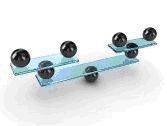

This is the starting point for getting acquainted with the 7-Scales project - an open source software project for Constructing, Analyzing, Log-booking and Executing SS7 Scenarios.
The final result of the 7-Scales project (the Project) is a software code that for simplicity is named herein the ´Code´ because it is not big enough to be classified as a ´software system´. However, this Code has many attributes that are inherent to the software systems; for this reason the description is based on the considerations and definitions of the book "System Analysis, Design, And Development - Concept, Principles, and Practices" by Charles S. Wasson, published by John Wiley & Sons, 2005 - a base that the author claims to be good enough for the goal. This grants that the approach applied here is systematic and uses consistent definitions and that, instead of reinventing the wheal, the experience accumulated in this field is reused.
Quite naturally, UML 2.0 has been chosen as a technical language to present the key aspects of the Code´s architecture in the scope and the depth of the book "Learning UML 2.0" by Kim Hamilton and Russell Miles, published by O’Reilly, 2006. Finally, UML diagrams have been developed by means of Enterprise Architect of the Sparx Systems, at first place for the simplicity and the 30-day free license.
This document presents the objectives of the Project, the architecture of the Code, the operation concept, the environment this Code is intended to be used in, and the roadmap as perceived by the author for the time being. It is meant to be the first document the reader gets acquainted with. Another document, a bit stiltedly named "Application Program Interface Description" is devoted to describing the minimum set of functions that the users of the Code need to be familiar with in order to develop successful scenarios. This comprises functions´ signatures, parameters´ explanation, short description of what a particular function does, relations, if any, to other functions and advices how to use them. This document is supplemented (or vice versa) by two scenarios in the Code that are intended be used as templates for developing other scenarios. No matter which supplements the other one, these two sources should be explored in parallel to maximize the efficiency of the time spent on them. Developing scenarios may need to be preceded by constructing some SS7 messages and TCAP operations that would require solid user´s experience and specs knowledge in this area. This undertaking is facilitated by two additional software programs, provided as compiled tools. The reason for this approach is to keep the base for developing scenarios unchanged - as long as the base structures are not mutated, the Order will reign over the Project; as soon as they are modified, the door for the Chaos to conquer the Project is open. Such an important activity appeals for a separate document to tutor the process of creating new signaling messages and adding definitions of TCAP operations and this is where "Creation of Message Templates and Operations Definitions" comes at hand. Note that this document explains how to create objects needed for the Code to execute a scenario; therefore it is not a tutor in the field of Signaling No.7 a considerable knowledge of which is considered to be present at users beforehand.
Back to Contents